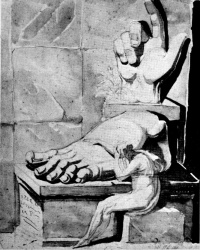Creativity
From The Art and Popular Culture Encyclopedia


|
Related e |
|
Featured: |
Creativity (or creativeness) is a mental process involving the generation of new ideas or concepts, or new associations between existing ideas or concepts.
From a scientific point of view, the products of creative thought (sometimes referred to as divergent thought) are usually considered to have both originality and appropriateness. An alternative, more everyday conception of creativity is that it is simply the act of making something new.
Although intuitively a simple phenomenon, it is in fact quite complex.
Creativity has been attributed variously to divine intervention, cognitive processes, the social environment, personality traits, and chance ("accident," "serendipity"). It has been associated with genius, mental illness and humour. Some say it is a trait we are born with; others say it can be taught with the application of simple techniques.
Contents |
Etymology
From Proto-Italic *krēāō (“to make grow”), from Proto-Indo-European *ḱer- (“to grow, become bigger”), the same root of crēscō.
Creativity in art and literature
Most people associate creativity with the fields of art and literature. In these fields, originality is considered to be a sufficient condition for creativity, unlike other fields where both originality and appropriateness are necessary.
Within the different modes of artistic expression, one can postulate a continuum extending from "interpretation" to "innovation". Established artistic movements and genres pull practitioners to the "interpretation" end of the scale, whereas original thinkers strive towards the "innovation" pole. Note that we conventionally expect some "creative" people (dancers, actors, orchestral members, etc.) to perform (interpret) while allowing others (writers, painters, composers, etc.) more freedom to express the new and the different.
Contrast alternative theories, for example:
- artistic inspiration, which provides the transmission of visions from divine sources such as the Muses; a taste of the Divine. Compare with invention.
- artistic evolution, which stresses obeying established ("classical") rules and imitating or appropriating to produce subtly different but unshockingly understandable work. Compare with crafts.
- artistic conversation, as in Surrealism, which stresses the depth of communication when the creative product is the language.
Creativity and mental health
Particularly strong links have been identified between creativity and mood disorders, particularly manic-depressive disorder (aka bipolar disorder) and depressive disorder (aka unipolar disorder). In Touched with Fire, Kay Redfield Jamison summarizes studies of mood-disorder rates in writers, poets and artists. She also explores research that identifies mood disorders in such famous writers and artists as Ernest Hemingway (who shot himself after electroconvulsive treatment), Virginia Woolf (who drowned herself when she felt a depressive episode coming on), composer Robert Schumann (who died in a mental institution), and even the famed visual artist, Michelangelo.
History of the concept of creativity
The ways in which societies have perceived the concept of creativity have changed throughout history, as has the term itself. The ancient Greek concept of art (in Greek, "techne" — the root of "technique" and "technology"), except for poetry, involved not freedom of action but subjection to rules. In Rome, the Greek concept was partly shaken, and visual artists were viewed as sharing, with poets, imagination and inspiration.
See also
- Artistic inspiration
- Brainstorming
- Innovation
- Invention (such as "artistic invention" in the Visual Arts)
- Musical improvisation
- The heroic theory of invention and scientific development
- Divine madness
- Greatness
- Why Man Creates (film)
- Confabulation (neural networks)

